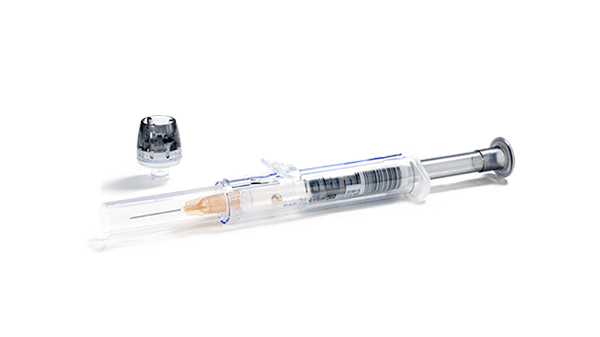
Removing air bubbles from a blood gas sample
Achieve sample integrity by removing air bubbles from a blood gas sample.
Expel air bubbles from a blood gas sample by gently tapping on the side of the syringe to bring the air bubbles to the top. Then expel them by pressing the plunger. You can place the tip of the syringe to a piece of gauze.
However, you can also expel the air bubbles through a vented tip cap, limiting the risk of blood contact. [1]
Effect of air bubbles in a blood gas sample
Air bubbles in blood gas samples may have a bias effect on the pO2 value. Depending on the initial pO2 value of the blood, the pO2 bias on blood gas results will be either positive or negative. The bias is often positive.
However, samples with high pO2 values can produce falsely lowered results because of the equilibration with the oxygen in the air bubble.
Effects on the patient and healthcare professionals
The presence of air bubbles in a blood gas sample can lead to wrong diagnosis. If false high or low pO2 is not recognized it may lead to errors when interpreting the results.Additionally, if during the process of expelling air bubbles and blood into a piece of gauze there is contact with blood you may be exposed to blood-borne pathogen. You risk exposing yourself to blood-borne pathogens when expelling air without using a vented safeTIPCAP.
Expel air bubbles from a blood gas sample
The vented safeTIPCAP forms a closed system, allowing you to expel any air bubbles and minimising the risk of blood exposure.The vented safeTIPCAP helps to seal the sample to prevent contact with atmospheric air. The safeTIPCAP stays on during aspiration of blood into the Radiometer analyser so you minimise the risk of blood contact.
The safePICO arterial blood gas syringe with safeTIPCAP
Easily expel air bubbles from an arterial blood gas sample while limiting the risk of blood contact using the safeTIPCAP on the safePICO syringe. The vented safeTIPCAP helps seal the sample immediately after blood collection and stays on during blood gas analysis.
The safePICO syringe is designed to help you reduce the risk of preanalytical errors.In addition to help remove air bubble in the sample, safePICO can help with homogeneous mixing without causing hemolysis, to reduce risk of needlestick injuries, a clotted blood sample or patient-sample mix-up.


References
1. Dukic L et al. Blood gas testing and related measurements: National recommendations on behalf of the Croatian Society of Medical Biochemistry and Laboratory Medicine. www.acutecaretesting.org Apr 2017.
Cookies are used on this website
Use of cookiesPlease enter a valid email
We will be sending an e-mail invitation to you shortly to sign in using Microsoft Azure AD.
It seems that your e-mail is not registered with us
Please click "Get started" in the e-mail to complete the registration process
Radiometer is using Microsoft AZURE Active Directory to authenticate users
Radiometer uses Azure AD to provide our customers and partners secure access to documents, resources, and other services on our customer portal.
If your organization is already using Azure AD you can use the same credentials to access Radiometer's customer portal.
Key benefits
- Allow the use of existing Active Directory credentials
- Single-sign on experience
- Use same credentials to access future services
Request access
You will receive an invitation to access our services via e-mail when your request has been approved.
When you accept the invitation, and your organization is already using AZURE AD, you can use the same credentials to access Radiometer's customer portal. Otherwise, a one-time password will be sent via e-mail to sign in.

